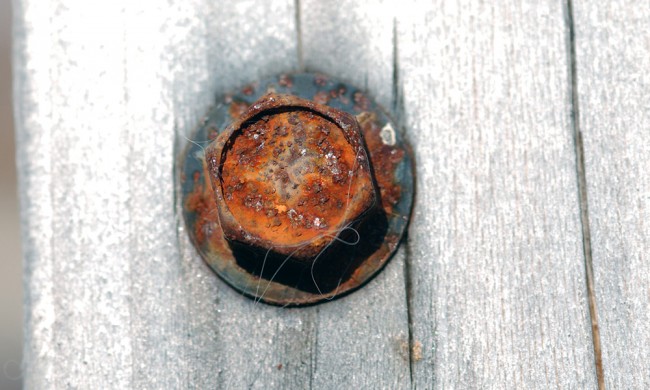
A Simple Boat Repair
by Patrick Williston
It took eight hours and had the emotional amplitude of an Italian opera. Blood, laughter, tears, elation—all were to be experienced on our beloved 42 year old sailboat. Not the birth of a child. Just a simple boat repair.
When the exhaust flange cracked on the gas inboard, we got by for longer than we should have using high-temperature silicone to fill the gaps. It prevented the carbon monoxide alarm from sounding for a few weeks, long enough for me to order a replacement muffler. Meanwhile, we all stayed out of the cabin while underway.
I timidly approached an early Saturday morning armed with tools, the replacement parts, and considerable reluctance. Flange bolts experience tremendous fluctuations in heat—they are prone to rust, and these bolts in particular had an orange and ornery look to them. They were deep in the belly of our boat, which is to say, difficult to reach.
When I finally got the first bolt to crack (with a good, knuckle-splitting tug), I nearly melted with joy.
[Blood]
A bolt has six sides, and an open-ended wrench has two positions available to grip the head of a bolt. The space in the engine compartment was so tight that it was necessary to use both positions, one after the other, to move the bolt 1/12th of a turn at a time—twelve grip changes for each painful rotation. It was tedious, but the day was young, and I was making measured progress.
Why is the first so often the easiest? The second flange bolt had different intentions, and no amount of effort would turn it. On the good advice of nautical friends, I applied magic penetrant (an elixir of acetone and vegetable oil), heat, and several solid whacks with a hammer. Still nothing.
What then? Drink coffee. Think about it. Try again.
Like some kind of miracle (aided by a wrench attached to a short cheater bar), the bolt turned for the first time since it was tightened 42 years ago. It turned again, even easier—hooray! It turned three more times, and then fell right out. Or at least half of it did. The other half of the bolt remained firmly nested in the exhaust manifold, its twisted end bright with newly exposed steel, gleaming in the soft glow of a trouble light. My simple repair had just become a lot less simple.
The old muffler was removed, and somewhere far above, the sun crested in the summer sky. I raced to the hardware store for cobalt drill bits and a bolt extractor. I would not give in so easily.
Cobalt drill bits are harder than steel, but they are also brittle. I broke a few while trying to keep steady pressure on the drill as the bit skated around on the broken bolt. After nearly an hour, I had made a slight depression. Another hour passed. I peered at my effort, looking carefully for signs of metal shavings. At long last, the drill bit sunk in to the chuck. I was through. I laughed out loud.
[Laughter]
The extractor would require a large hole to gain purchase on the remaining steel. I replaced the bit with a larger one and returned to my toil. Keeping the drill speed low, I attempted to bring a fragile calm to the tender task. Wrong move. The sharp edge of the bit sliced hard into the steel, driving deeply into the hole. This is when the cobalt bit broke off. In the hole. The hole that I had just spent nearly three hours drilling.
[Tears]
Time for coffee.
What do you do when you have a cobalt drill bit stuck in the hole you have drilled through a broken bolt? You reassure yourself that you are not the first person to do this, and then you consult the wisdom of the internet.
There are some good ideas on the internet, but precious few I could attempt within the confines of the engine compartment. For example: “Weld a nail to the end of the broken drill bit”—but then what? One idea caught my eye. I gave it a try. I carefully fed thin-gauge steel wire through the flutes of the drill bit until the wire emerged on the back side of the hole, inside the exhaust manifold. I reached my fingers through the exhaust port and was able to grasp the far end of the wire. I gently worked the wire back and forth like dental floss. Out popped the drill bit. A loose tooth.
[Elation]
How can such a simple, meaningless event elicit so much joy? I have no idea why, but I assure you, it can.
An extractor works by reverse-threading into the hollowed out bolt shaft, unwinding the bolt from the inside. After a few squeamish attempts—now certain that the extractor, too, would shatter in the precious hole—I resigned to enlarging the hole and re-tapping the threads. At any rate, I only had a few of the larger cobalt bits left. This time I excavated at high speed, and metal shavings sprinkled like fairy dust. The tap mercifully found the old threads, and atom by atom, the bolt was removed.
How long does it take to remove a couple of bolts on an old motor? I know the answer. It takes as long as it takes, and sometimes that can be a pretty long time.
Of course, the new muffler did not fit quite the same way as the old one, and I had to quickly return to the marine supply shop for hoses and clamps before it closed. As day turned to night, eagles squabbled in the hemlock trees, and the new pieces of the exhaust system were wrestled into their proper places.
I did not have the courage to start the motor that evening.
It did, however, start fairly well the next morning.
It doesn’t always.



